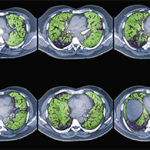 Undifferentiated connective tissue disease (UCTD) is a diagnosis given to patients who do not fulfill current classification criteria for named connective tissue diseases (CTD)—systemic lupus erythematosus (SLE), rheumatoid arthritis (RA), systemic sclerosis (SSc), or Sjögren’s disease—but who nonetheless have clinical signs and symptoms and serological evidence of autoimmune CTDs.
Undifferentiated connective tissue disease (UCTD) is a diagnosis given to patients who do not fulfill current classification criteria for named connective tissue diseases (CTD)—systemic lupus erythematosus (SLE), rheumatoid arthritis (RA), systemic sclerosis (SSc), or Sjögren’s disease—but who nonetheless have clinical signs and symptoms and serological evidence of autoimmune CTDs.
In 1980 LeRoy et al. were the first investigators to use the term UCTD, which they considered an early phase of a forthcoming CTD, the features of which would eventually fulfill classification criteria for a named diagnosis.1 For example, patients whose symptoms meet some criteria for SLE are often interchangeably described as having UCTD or incomplete SLE.2
Up to 60% of patients with UCTD, however, do not progress to a named CTD in the first three to five years after diagnosis; they are described as having stable UCTD.3-5
Many patients with UCTD have mild symptoms, but a subset may develop serious clinical manifestations or require hospitalization. Thus, risk stratification of patients based on progression of disease to defined CTDs or more serious manifestations may allow for earlier intervention and avoidance of unnecessary tests or therapy.
Believing that a consensus definition of UCTD will inform future studies and improve clinical care, we describe here the scope of the challenge posed by UCTD, discuss the opinions of involved stakeholders and review current research on its definition.
The Challenge
UCTD is heterogenous and variable in its clinical presentations, making it difficult to diagnose, manage and study. In 1999 Mosca et al. proposed these preliminary UCTD classification criteria:6
- Signs and symptoms suggestive of a named CTD, but not fulfilling classification criteria;
- Positive anti-nuclear antibody test; and
- Disease duration of at least three years.
Currently, 44 years after LeRoy’s first description and 25 years after Mosca’s proposal, neither official criteria for nor consensus guidelines regarding the diagnosis and management of UCTD exist.4 Instead, doctors diagnose UCTD retrospectively, when a patient’s illness has not evolved to a named CTD after three years.7
Classification criteria for named CTDs, which can include or exclude a UCTD diagnosis, are periodically revised. For example, a patient is diagnosed with UCTD because she does not fit 1997 SLE criteria. Because SLE criteria were updated in 2019, with no change in her course, she is now said to have SLE. The opposite is also true. With the new criteria, as many as 50% of patients diagnosed with a named CTD, such as SLE, may now be diagnosed as having UCTD.8
We believe that standardization of criteria for UCTD will unify research, predict which patients’ illnesses will evolve to a named CTD, improve communication and, hopefully, improve outcomes.
Who Is Impacted?
Diagnosis names inform patient care and dictate research efforts. They influence administration, communication and public policy.9 Heterogeneous definitions, small sample sizes and lack of comparison groups weaken studies of UCTD.
UCTD lacks standardized billing codes. Standardized billing codes for named diagnoses are the basis for treatment, study, billing and reimbursement for physicians, researchers and insurance companies.
Diagnostic uncertainty causes patient anxiety and discomfort. Patients with UCTD describe rheuma-frustration, sadness and feelings of self-consciousness resulting from the lack of understanding and awareness of UCTD.10 Patient fear may arise from the uncertainty surrounding their prognosis and risk of progression to a more defined CTD. Although UCTD is typically associated with fewer or less severe disease manifestations than defined CTDs, patients with this diagnosis similarly perceive a worse physical and mental quality of life than members of the general population.11,12
Preliminary data from our institution suggest that patients with UCTD, compared with those with SLE, may experience a similar degree of anxiety, depression and fatigue (unpublished data); as our data collection is ongoing, this will be confirmed in future studies.
Psychosocial interventions—educational materials, support groups and counseling—may be important in helping patients cope with a UCTD diagnosis.10
Risk Factors for Disease Progression
The evolution from UCTD to a definable CTD most often occurs within the first five years of UCTD onset. One meta-analysis published in 2023 by Rubio and Kyttaris found that UCTD most commonly progresses to SLE and RA.13
The variability between research cohorts defining and studying UCTD makes it difficult to assess risk factors associated with disease progression. However, multiple meta-analyses have proposed clinical and serological disease features of UCTD which increase the risk of developing a defined CTD. Clinical observations (e.g., Raynaud’s phenomenon, polyarthritis, photosensitivity, sicca, abnormal nailfold-capillaroscopy), routine blood tests (e.g., cytopenias) and serologies (e.g., high-level anti-nuclear antibody titers, anti-centromere, antiphospholipid or RNP antibodies) at baseline are seen at higher frequencies in patients who evolve to a CTD compared with those who do not.13,14
As may be expected, the presence of key clinical features of defined CTDs—including serositis, renal involvement, positive anti-Smith antibody and hypocomplementemia for SLE and SSc-specific antibodies and NFC abnormalities for SSc—increase the risk of progression to each respective disease.15 Early recognition of risk factors for disease progression will help physicians identify which patients require closer monitoring and potential intervention. Although the aforementioned features are thought to increase the risk of disease progression, they require further evaluation using predictive models and UCTD cohorts that utilize the same inclusion and exclusion criteria.
Moving Forward
To improve understanding and acceptance of a UCTD diagnosis, the Barbara Volcker Center at the Hospital for Special Surgery (HSS), New York, has created a prospective Undifferentiated Connective Tissue Disease and Overlap Registry that systematically reviews medical records of patients with UCTD to verify they do not meet ACR/EULAR-endorsed classification criteria for SLE, SSc, RA, Sjögren’s, inflammatory myopathy or antiphospholipid syndrome, then annually collects clinical data and biologic samples.1
Identification of demographic and medical factors, as well as defining molecular phenotypes in patients with UCTD, may improve diagnostic accuracy and risk stratification. The main goals are to correlate UCTD clinical and biomarker phenotypes, track disease evolution, predict conversion to a named CTD and compare the psychosocial well-being of patients with UCTD to that of patients with SLE.
In its short life, our registry has enrolled more than 250 patients (96% female, 74% white, mean age at enrollment 47.2 years +/-14.3) with rheumatologist diagnosed UCTD whom we predict will answer our initial questions. A preliminary cohort analysis found that nearly a third of our patients with rheumatologist-diagnosed UCTD fulfilled ACR/EULAR-endorsed classification criteria for a CTD, highlighting issues of diagnostic ambiguity: Rheumatologists diagnose patients with UCTD even when they meet criteria for a CTD.16
We plan to continue collecting annual follow-up data on the subset of patients in our cohort with UCTD (currently >150). We expect these large-scale efforts will identify which factors predict which patients will remain stable and which will evolve, reducing the uncertainty of UCTD and improving patient care.
In addition to these research efforts, the Barbara Volcker Center at HSS sponsored a conference on uncertainty in April 2021, When a Diagnosis Has No Name. The two-day, international workshop offered participants from all areas of medicine—patient care, basic and clinical research, industry, federal regulatory agencies, insurers, administrators, and patients—the opportunity to discuss and analyze perspectives on diagnostic uncertainty.
The conference was a first step in deconstructing concepts of diagnostic uncertainty, bringing patients who are often excluded from research to the forefront of the conversation and building a common vocabulary to quantify uncertainty. A resulting summary paper outlines the workshop’s main discussion points, conclusions and recommendations.9 The resulting textbook, Diagnoses Without Names provides more detailed accounts of workshop participants’ data and perspectives on diagnostic uncertainty.17
Moving forward, clear criteria for UCTD are vital for refining research, enhancing diagnostic precision, and improving patient care. We hope to see advancements in the management and understanding of UCTD that lead to improved patient outcomes and reduced uncertainty in the field of rheumatology.
Lucy Masto, BS, is a clinical research assistant at the Hospital for Special Surgery, New York.
Medha Barbhaiya, MD, MPH, is a rheumatologist and clinical researcher at the Hospital for Special Surgery and Weill Cornell Medicine, New York.
Caroline H. Siegel, MD, MS, is a rheumatologist and clinical researcher at the Hospital for Special Surgery and Weill Cornell Medicine, New York.
Lisa R. Sammaritano, MD, is the director of the Rheumatology Reproductive Health Program at the Barbara Volcker Center for Women and Rheumatic Diseases, Hospital for Special Surgery, and professor of clinical medicine at Weill Cornell Medicine, New York.
Michael D. Lockshin, MD, is director emeritus of the Barbara Volcker Center for Women and Rheumatic Diseases at the Hospital for Special Surgery, New York. He served as editor in chief of Arthritis & Rheumatism and has been recognized with national awards from the Arthritis Foundation, the ACR and the Lupus Foundation of America.
References
- Leroy EC, Maricq HR, Kahaleh MB. Undifferentiated connective tissue syndromes. Arthritis Rheum. 1980 Mar;23(3):341–343.
- Ugarte‐Gil MF, Alarcón GS. Incomplete systemic lupus erythematosus: Early diagnosis or overdiagnosis? Arthritis Care Res (Hoboken). 2016 Mar;68(3):285–287.
- Drehmel KR, Erickson AR, England BR, et al. Applying SLICC and ACR/EULAR systemic lupus erythematosus classification criteria in a cohort of patients with undifferentiated connective tissue disease. Lupus. 2021 Feb;30(2):280–284.
- Antunes M, Scirè CA, Talarico R, et al. Undifferentiated connective tissue disease: State of the art on clinical practice guidelines. RMD Open. 2019 Feb;4(Suppl 1):e000786.
- Sciascia S, Roccatello D, Radin M, et al. Differentiating between UCTD and early-stage SLE: From definitions to clinical approach. Nat Rev Rheumatol. 2022 Jan;18(1):9–21.
- Mosca M, Neri R, Bombardieri S. Undifferentiated connective tissue diseases (UCTD): A review of the literature and a proposal for preliminary classification criteria. Clin Exp Rheumatol. 1999;17(5):615–620.
- Marwa K, Anjum F. Undifferentiated Connective Tissue Disease. Treasure Island (FL): StatPearls Publishing; 2023 Apr 27.
- Jia L, Levine AB, Lockshin MD. American College of Rheumatology criteria for systemic lupus erythematosus exclude half of all systemic lupus erythematosus patients. Arthritis Rheumatol. 2017 Jul;69(7):1502–1503.
- Lockshin MD, Crow MK, Barbhaiya M. When a diagnosis has no name: Uncertainty and opportunity. ACR Open Rheumatol. 2022 Mar;4(3):197–201.
- Siegel CH, Kleinman J, Barbhaiya M, et al. The psychosocial impact of undifferentiated connective tissue disease on patient health and well-being: A qualitative study. J Clin Rheumatol. 2022 Mar;28(2):e340–e347.
- Mosca M, Tani C, Vagnani S, et al. The diagnosis and classification of undifferentiated connective tissue diseases. J Autoimmun. 2014 Feb–Mar;48–49:50–52.
- Iudici M, Irace R, Riccardi A, et al. Longitudinal analysis of quality of life in patients with undifferentiated connective tissue diseases. Patient Relat Outcome Meas. 2017 Feb;8:7–13.
- Rubio J, Kyttaris VC. Undifferentiated connective tissue disease: Comprehensive review. Curr Rheumatol Rep. 2023 May;25(5):98–106.
- García-González M, Rodríguez-Lozano B, Bustabad S, et al. Undifferentiated connective tissue disease: Predictors of evolution into definite disease. Clin Exp Rheumatol. 2017 Sep–Oct;35(5):739–745.
- Dyball S, Rodziewicz M, Mendoza-Pinto C, et al. Predicting progression from undifferentiated connective tissue disease to definite connective tissue disease: A systematic review and meta-analysis. Autoimmun Rev. 2022 Nov;21(11):103184.
- Siegel CH, Stamm B, Vega J, Lockshin MD, et al. Characteristics of patients diagnosed with undifferentiated connective tissue disease [AB0556]. Ann Rheum Dis. 2022;81(Suppl 1):1405.1–1405.
- Lockshin MD, Crow MK, Barbhaiya M, eds. Diagnoses Without Names: Challenges for Medical Care, Research, and Policy. Cham, Switzerland: Springer International Publishing; 2022.

